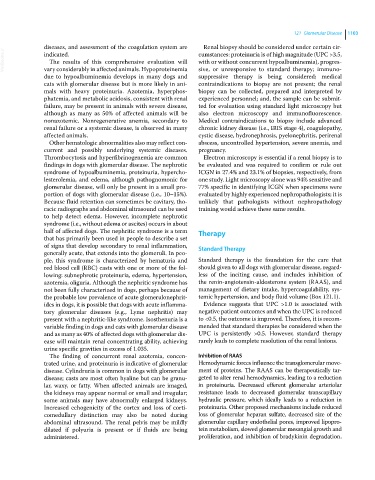Page 1165 - Clinical Small Animal Internal Medicine
P. 1165
121 Glomerular Disease 1103
diseases, and assessment of the coagulation system are Renal biopsy should be considered under certain cir-
VetBooks.ir indicated. cumstances: proteinuria is of high magnitude (UPC >3.5,
with or without concurrent hypoalbuminemia), progres-
The results of this comprehensive evaluation will
vary considerably in affected animals. Hypoproteinemia
due to hypoalbuminemia develops in many dogs and sive, or unresponsive to standard therapy; immuno-
suppressive therapy is being considered; medical
cats with glomerular disease but is more likely in ani- con traindications to biopsy are not present; the renal
mals with heavy proteinuria. Azotemia, hyperphos- biopsy can be collected, prepared and interpreted by
phatemia, and metabolic acidosis, consistent with renal experienced personnel; and, the sample can be submit-
failure, may be present in animals with severe disease, ted for evaluation using standard light microscopy but
although as many as 50% of affected animals will be also electron microscopy and immunofluorescence.
nonazotemic. Nonregenerative anemia, secondary to Medical contraindications to biopsy include advanced
renal failure or a systemic disease, is observed in many chronic kidney disease (i.e., IRIS stage 4), coagulopathy,
affected animals. cystic disease, hydronephrosis, pyelonephritis, perirenal
Other hematologic abnormalities also may reflect con- abscess, uncontrolled hypertension, severe anemia, and
current and possibly underlying systemic diseases. pregnancy.
Thrombocytosis and hyperfibrinogenemia are common Electron microscopy is essential if a renal biopsy is to
findings in dogs with glomerular disease. The nephrotic be evaluated and was required to confirm or rule out
syndrome of hypoalbuminemia, proteinuria, hypercho- ICGN in 27.4% and 23.1% of biopsies, respectively, from
lesterolemia, and edema, although pathognomonic for one study. Light microscopy alone was 94% sensitive and
glomerular disease, will only be present in a small pro- 77% specific in identifying ICGN when specimens were
portion of dogs with glomerular disease (i.e., 10–15%). evaluated by highly experienced nephropathologists; it is
Because fluid retention can sometimes be cavitary, tho- unlikely that pathologists without nephropathology
racic radiographs and abdominal ultrasound can be used training would achieve these same results.
to help detect edema. However, incomplete nephrotic
syndrome (i.e., without edema or ascites) occurs in about
half of affected dogs. The nephritic syndrome is a term Therapy
that has primarily been used in people to describe a set
of signs that develop secondary to renal inflammation, Standard Therapy
generally acute, that extends into the glomeruli. In peo-
ple, this syndrome is characterized by hematuria and Standard therapy is the foundation for the care that
red blood cell (RBC) casts with one or more of the fol- should given to all dogs with glomerular disease, regard-
lowing: subnephrotic proteinuria, edema, hypertension, less of the inciting cause, and includes inhibition of
azotemia, oliguria. Although the nephritic syndrome has the renin‐angiotensin‐aldosterone system (RAAS), and
not been fully characterized in dogs, perhaps because of management of dietary intake, hypercoagulability, sys-
the probable low prevalence of acute glomerulonephrit- temic hypertension, and body fluid volume (Box 121.1).
ides in dogs, it is possible that dogs with acute inflamma- Evidence suggests that UPC >1.0 is associated with
tory glomerular diseases (e.g., Lyme nephritis) may negative patient outcomes and when the UPC is reduced
present with a nephritic‐like syndrome. Isosthenuria is a to <0.5, the outcome is improved. Therefore, it is recom-
variable finding in dogs and cats with glomerular disease mended that standard therapies be considered when the
and as many as 40% of affected dogs with glomerular dis- UPC is persistently >0.5. However, standard therapy
ease will maintain renal concentrating ability, achieving rarely leads to complete resolution of the renal lesions.
urine specific gravities in excess of 1.035.
The finding of concurrent renal azotemia, concen- Inhibition of RAAS
trated urine, and proteinuria is indicative of glomerular Hemodynamic forces influence the transglomerular move-
disease. Cylindruria is common in dogs with glomerular ment of proteins. The RAAS can be therapeuti cally tar-
disease; casts are most often hyaline but can be granu- geted to alter renal hemodynamics, leading to a reduction
lar, waxy, or fatty. When affected animals are imaged, in proteinuria. Decreased efferent glomerular arteriolar
the kidneys may appear normal or small and irregular; resistance leads to decreased glomerular transcapillary
some animals may have abnormally enlarged kidneys. hydraulic pressure, which ideally leads to a reduction in
Increased echogenicity of the cortex and loss of corti- proteinuria. Other proposed mechanisms include reduced
comedullary distinction may also be noted during loss of glomerular heparan sulfate, decreased size of the
abdominal ultrasound. The renal pelvis may be mildly glomerular capillary endot helial pores, improved lipopro-
dilated if polyuria is present or if fluids are being tein metabolism, slowed glomerular mesangial growth and
administered. proliferation, and inhibition of bradykinin degradation.

